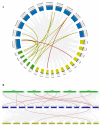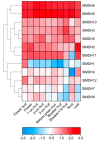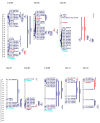Identification and Characterization of Malate Dehydrogenases in Tomato (Solanum lycopersicum L.)
- PMID: 36077425
- PMCID: PMC9456053
- DOI: 10.3390/ijms231710028
Identification and Characterization of Malate Dehydrogenases in Tomato (Solanum lycopersicum L.)
Abstract
Malate dehydrogenase, which facilitates the reversible conversion of malate to oxaloacetate, is essential for energy balance, plant growth, and cold and salt tolerance. However, the genome-wide study of the MDH family has not yet been carried out in tomato (Solanum lycopersicum L.). In this study, 12 MDH genes were identified from the S. lycopersicum genome and renamed according to their chromosomal location. The tomato MDH genes were split into five groups based on phylogenetic analysis and the genes that clustered together showed similar lengths, and structures, and conserved motifs in the encoded proteins. From the 12 tomato MDH genes on the chromosomes, three pairs of segmental duplication events involving four genes were found. Each pair of genes had a Ka/Ks ratio < 1, indicating that the MDH gene family of tomato was purified during evolution. Gene expression analysis exhibited that tomato MDHs were differentially expressed in different tissues, at various stages of fruit development, and differentially regulated in response to abiotic stresses. Molecular docking of four highly expressed MDHs revealed their substrate and co-factor specificity in the reversible conversion process of malate to oxaloacetate. Further, co-localization of tomato MDH genes with quantitative trait loci (QTL) of salt stress-related phenotypes revealed their broader functions in salt stress tolerance. This study lays the foundation for functional analysis of MDH genes and genetic improvement in tomato.
Keywords: QTL mapping; abiotic stress; gene expression; genome analysis; malate dehydrogenase; molecular docking; salt stress; tomato.
Conflict of interest statement
The authors declare no conflict of interest.
Figures









Similar articles
-
Genome-wide systematic characterization of the bZIP transcriptional factor family in tomato (Solanum lycopersicum L.).BMC Genomics. 2015 Oct 12;16:771. doi: 10.1186/s12864-015-1990-6. BMC Genomics. 2015. PMID: 26459863 Free PMC article.
-
Genome-Wide Characterization and Gene Expression Analyses of Malate Dehydrogenase (MDH) Genes in Low-Phosphorus Stress Tolerance of Chinese Fir (Cunninghamia lanceolata).Int J Mol Sci. 2023 Feb 23;24(5):4414. doi: 10.3390/ijms24054414. Int J Mol Sci. 2023. PMID: 36901845 Free PMC article.
-
Genome-wide identification and characterization of the thioredoxin (TRX) gene family in tomato (Solanum lycopersicum) and a functional analysis of SlTRX2 under salt stress.Plant Physiol Biochem. 2025 Mar;220:109478. doi: 10.1016/j.plaphy.2025.109478. Epub 2025 Jan 7. Plant Physiol Biochem. 2025. PMID: 39826344
-
Genome-Wide Identification of the WD40 Gene Family in Tomato (Solanum lycopersicum L.).Genes (Basel). 2023 Jun 15;14(6):1273. doi: 10.3390/genes14061273. Genes (Basel). 2023. PMID: 37372453 Free PMC article. Review.
-
Malate valves: old shuttles with new perspectives.Plant Biol (Stuttg). 2019 Jan;21 Suppl 1(Suppl Suppl 1):21-30. doi: 10.1111/plb.12869. Epub 2018 Jul 17. Plant Biol (Stuttg). 2019. PMID: 29933514 Free PMC article. Review.
Cited by
-
Integrated Transcriptomic and Proteomic Analysis of Nutritional Quality-Related Molecular Mechanisms in "Longjia", "Yangpao", and "Niangqing" Walnuts (Juglans sigillata).Int J Mol Sci. 2024 Oct 30;25(21):11671. doi: 10.3390/ijms252111671. Int J Mol Sci. 2024. PMID: 39519221 Free PMC article.
-
Quantitative Trait Loci Identification and Candidate Genes Characterization for Indole-3-Carbinol Content in Seedlings of Brassica napus.Int J Mol Sci. 2025 Jan 19;26(2):810. doi: 10.3390/ijms26020810. Int J Mol Sci. 2025. PMID: 39859526 Free PMC article.
-
Integrating Proteomics and Metabolomics Approaches to Elucidate the Mechanism of Responses to Combined Stress in the Bell Pepper (Capsicum annuum).Plants (Basel). 2024 Jul 5;13(13):1861. doi: 10.3390/plants13131861. Plants (Basel). 2024. PMID: 38999705 Free PMC article.
-
OsMDH12: A Peroxisomal Malate Dehydrogenase Regulating Tiller Number and Salt Tolerance in Rice.Plants (Basel). 2023 Oct 13;12(20):3558. doi: 10.3390/plants12203558. Plants (Basel). 2023. PMID: 37896021 Free PMC article.
-
Recent Advances in Studying the Regulation of Fruit Ripening in Tomato Using Genetic Engineering Approaches.Int J Mol Sci. 2024 Jan 7;25(2):760. doi: 10.3390/ijms25020760. Int J Mol Sci. 2024. PMID: 38255834 Free PMC article. Review.
References
MeSH terms
Substances
Grants and funding
LinkOut - more resources
Full Text Sources

